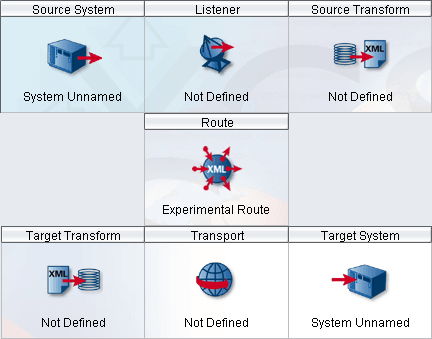Routing Panel
The Routing Panel is the central point of access for the eiConsole and general route design. The current route is represented in a table, where rows represent individual sources or targets (with no particular emphasis on position). Columns are somewhat more significant for the meaning of individual components. The center column, the “Route” column, represents the hub point for all transformations across the route. Rows to the left of this point are sources, and rows to the right are targets. Multiple sources and targets may be used, with the Route column determining the basic heuristics of the routing between the various sources and targets.

Source System Component
The Source System Component defines a source system, which has no actual significance on the transformation itself. The Information Panel used by this component is shared by the Source Transform Component, which is the Transform Panel. This column is essentially used to represent this particular source path with a name.
Listener Component
The Listener Component defines listeners for the source it resides in. Listeners are used to collect data for the source and can be treated as entrances for the route. Typically, a listener is either passive or active and may do anything from scanning a directory for new files to taking in data from a web form via an HTTP post. The Information Panel for a Listener Component is defined as the Listener Panel.
Source Transform Component
The Source Transform Component defines a transformation stage for the source in which it resides. Typically, transformations are to a common format shared by the routing hub (such as XML), particularly in the case of having multiple sources and/or targets. A transformation is not required but generally used in at least the source or target stage. The Information Panel for the Source Transform Component is the Transform Panel.
Route Component
The Route Component acts as the hub for all sources and targets, specifying the routing rules throughout the interface. This component includes options specific to the route as a whole, such as error reporting. The Information Panel for the Route Component is the Route Panel.
Target Transform Component
The Target Transform Component defines the transformation for the target path it resides in. Generally speaking, this transformation is from a common format used in the routing hub (such as XML) to a specific format employed by the target system (like a tab delimited file or database entry). No transformation is strictly required, and in many interfaces are not necessary after data has been transformed into the format common to the entire interface. The Information Panel for the Target Transform Component is the Transform Panel, which varies only in the direction from the Source Transform Component’s Information Panel.
Transport Component
The Transport Component defines a transport mechanism for the target path it resides in. A transport is essentially the delivery method and location of the data passed along its target path. Data may be transported via this component to a directory as a file, to a database, or to some other mechanism and/or storage system. The Information Panel for the Transport Component is the Transport Panel. It has a lot in common with the Listener Panel.
Target System Component
The Target System Component defines the metadata for the target path it resides in. This component has no functional effect on the route itself, but rather provides information for the particular target it represents (such as a name). The Information Panel for the Target System Component is shared with the Target Transform Component.
Related Areas
Main Window
“The Main Window is the central component of the PilotFish eiConsole. All modifications and plans may be put into effect from this window or one…”
